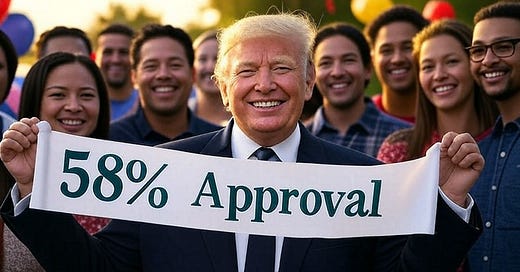The New Surprising Trump Constituency
Any guesses as to who is in this group? Read on and learn.
Conventional wisdom, meaning corporate media, portrays President Donald Trump’s supporters as white supremacists, xenophobes, and racists. They are extras in the movie Deliverance, with two teeth and a below room temperature IQ.
Yet Trump won reelection easily last November, gaining support from more than just the Billy Bobs in Appalachia. Where does Trump’s support stand now that he has been president for three months, allowing everyone to see his presidential agenda clearly?
Instead of examining legacy media’s commissioned polls, which aim more to shape public opinion than to reflect it, let’s refer to Rasmussen Reports, one of the most accurate polling organizations.
In late April, as Trump’s second quarter in the White House began, Rasmussen Reports surveyed 1,767 likely voters. Likely voters elect presidents, unlike simply registered voters or anyone who answers the pollster’s phone call.
Overall, 47% of likely U.S. voters either strongly or somewhat approve of President Trump at this time. Trump’s approval has been hovering around 50% during his current term, which is not surprising given our divided country and the media's hostility toward Trump and his administration.
Specifically, the Media Research Center found that 92% of Trump's coverage during his first 100 days was negative. For low-information voters who receive only a few minutes of news each day from cable networks, this constant onslaught of negativity will shape their opinions.
The biggest surprise is Trump's 58% approval rating among Hispanic voters, which is higher than that of white voters at 47% and black voters at 41%.
By income, the middle class, with annual earnings between $50,000 and $200,000, comprises about 48% of pro-Trump voters, while wealthier voters show only 34% approval of Trump. This confirms that Trump is shifting the Republican Party towards the working class, while the Democrats are increasingly seen as the party of the educated and affluent laptop classes.
Education correlates negatively with Trump favorability, as only 36% of those who have attended graduate school approve of Trump.
There are also gender differences. Fifty-two percent (52%) of men approve of Trump, compared to only 43% of women. There were no significant differences between the young, middle-aged, and older generations, with approval rates at about 48%.
This confirms other surveys showing that college-educated women make up over a third of the Democrat Party.
So, what does all this mean? The biggest surprise is that Hispanic voters have a 58% approval rating for Trump. Here are some possible reasons why:
– First, economic priorities are critical. The survey doesn’t directly break down issue priorities. Still, Trump’s messaging on economic growth, tax cuts, and energy costs likely resonated with Hispanic voters, many of whom are working-class or small business owners. In particular, Hispanic men may connect with Trump’s economic optimism.
– Second, cultural and ideological alignment play a role. The data shows that 56% of Hispanic voters believe the country is on the “right direction,” which is higher than the percentages for White (41%) or Black (38%) voters, suggesting alignment with Trump’s agenda. This may reflect conservative values among evangelical or Catholic Hispanics, particularly regarding family values or opposition to progressive social policies.
– Third, Trump’s campaign successfully targeted specific Hispanic subgroups, including Cuban-Americans and Venezuelans, using anti-socialist rhetoric that resonates with those wary of the Democrats’ leftist policies.
Ultimately, the Democratic Party’s perceived disconnect — prioritizing immigration reform over economic issues — may have led some Hispanic voters to Trump, who presented himself as a pragmatic outsider.
The high approval among Hispanics, despite Trump’s immigration rhetoric, suggests that many prioritize economic and cultural issues over concerns regarding immigration policy.
The Rasmussen Reports data highlights Trump’s strong appeal among Hispanic voters, fueled by economic priorities, cultural alignment, targeted messaging, and Democratic missteps.
These missteps include supporting illegal alien gang members while Democrats embarrass themselves by traveling to El Salvador to lobby for the deportation of its own criminal citizens to the US. Additionally, Democrat-aligned judges hinder Trump’s efforts to deport those living in America illegally.
While Democratic efforts may attract East Coast elites whose lives are not adversely affected by illegal immigration and its related economic, social, and crime issues, their advocacy can alienate Hispanic voters who have followed the rules and laws to be in America legally and who are also negatively impacted by the influx of illegal immigrants.
Clearly, President Trump has tapped into an issue with broad support, including from Hispanic voters. Republican members of Congress should take note and use their legislative authority to formalize Trump’s executive orders into law, especially if they wish to maintain a majority after the upcoming midterm elections.
Brian C. Joondeph, M.D., is a physician and writer.
Follow me on Twitter @retinaldoctor
Substack Dr. Brian’s Substack
Truth Social @BrianJoondeph
LinkedIn @Brian Joondeph
Email brianjoondeph@gmail.com




